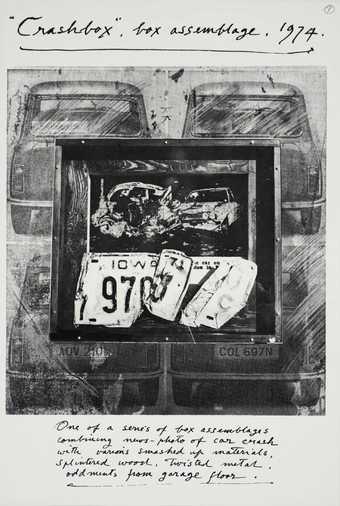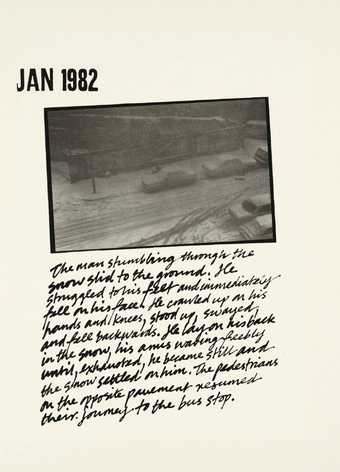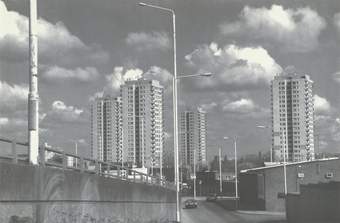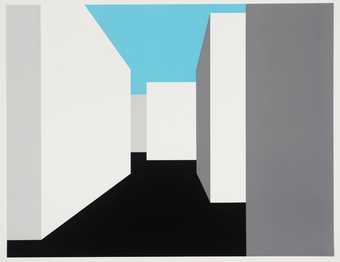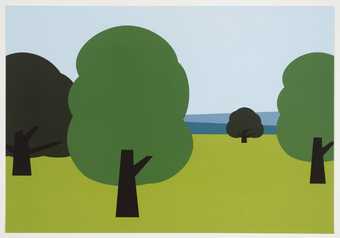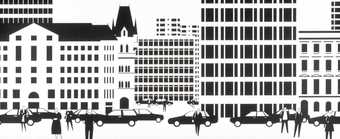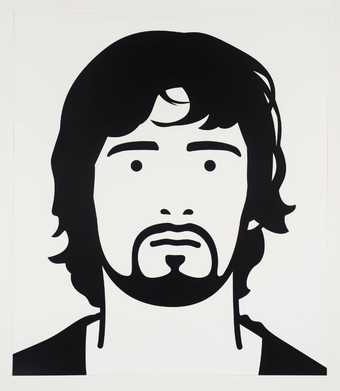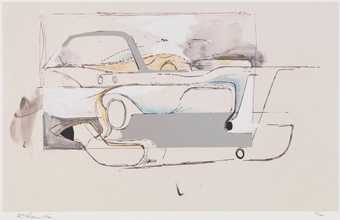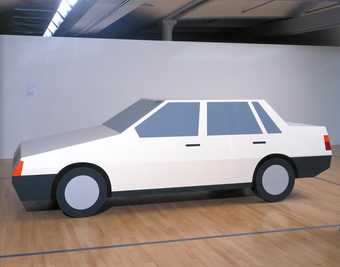
Not on display
- Artist
- Julian Opie born 1958
- Medium
- Screenprint on paper
- Dimensions
- Image: 610 × 1049 mm
Frame: 1106 X 623 × 31mm - Collection
- Tate
- Acquisition
- Purchased 1999
- Reference
- P78313
Summary
Cars? is one of a series of six screenprints Opie produced in 1998-9. The series was printed by Advanced Graphics, London and published by Alan Cristea Gallery, London, in an edition of forty plus ten artist’s proofs. Tate’s version is number four in the edition. Other individual prints in the series are Imagine you are walking (Tate P78310), Imagine you are driving (Tate P78311), Landscape? (Tate P78312), Cityscape? (Tate P78314) and Gary, popstar (Tate P78315). The prints were made from hand-cut stencils based on photographs that Opie altered on a computer. Much of this imagery is similar to his paintings and work in other media of the mid 1990s. Do you ever think of me? 1996 (thirteen versions,
1-3, Arts Council of Great Britain) is an iris print closely resembling Cars?. Opie also made a series of sculptures representing cars in 1996. You are driving a Volvo (Tate T07207) is, as its title indicates, a life-size sculptural version of a Volvo. Other car models include a red Volkswagen, a white Ford Cortina Estate, a red Peugeot 205 and a blue Subaru. An artist’s book featuring some of these cars, titled Driving in the country, was produced in 1996 by the Centre de Création Contemporaine, Tours, during Opie’s residency at the Atelier Calder, Sache, France.
Cars? is a stylised representation of three cars on a road. One is red, one is white and one is yellow. All are cropped, partial views. The red and yellow cars, travelling from left to right, are cut at rear and front by the picture frame. The white car, travelling in the opposite direction, is half hidden by the red car in front of it. The cropping suggests the cars’ movement across the picture plane. The cars’ windows are blank and reveal nothing of their interiors. Narrow strips of dark grey represent door handles and, on the red car, a line of horizontal trimming. The lower half of each car body is a slightly darker shade, indicating contour. Difference in styles – denoted by the shape of the car body and its windows – may be related to the earlier sculptures. The road is a simple horizontal area of black, interrupted only by white road markings. Between the bumpers of the yellow and white cars a small strip of dark green represents the landscape. Above the cars, filling nearly two thirds of the image, a large area of blue represents a cloudless sky. All the colours are monotone.
Opie derives his images from his immediate personal experience but depersonalises them in order to offer the viewer a commodity, that of being able to make his or her own individual imaginative journey. This process of commodification is most overtly referred to in Opie’s recent work in which both sculptures and prints have multiple versions and possibilities for combination. One of his recent catalogues, published by the Lisson Gallery, London in 2001, takes the form of a mail-order catalogue, which illustrates and lists variable formats and prices for a range of sculptures and prints. Much of Opie’s work of the late 1990s simulates the symbolic landscape of computer games and children’s picture books and encourages the viewer to journey into a stylised representation of the world, emptied of human presence. His deliberately bland imagery provides pared down visual symbols for everyday objects and experiences. A catalogue of his work, such as that cited above, may be seen as providing the visual alphabet for a language, similar to that used by the creators of road signs, corporate logos and digital games, appropriated and personalised by the artist. Opie has said: ‘what I would really like to do is make a painting and then walk into it’ (quoted in Julian Opie 1997, p.52) and ‘I think my work is about trying to be happy ... I want the world to seem like the kind of place you’d want to escape into ... Mundane things are just as exciting as all the things you might imagine escaping into.’ (Quoted in Julian Opie, exhibition catalogue, Ikon, Birmingham 2001, pp.4 and 8.) These statements suggest that the processes of his work may have an idealising or utopic function, which is belied by the blank emptiness of his imagery. The question mark in the title of Landscape? indicates a query about what is being represented. Opie’s visual symbols and his system of commodification suggest that the utopic ideals represented by these systems may result, paradoxically, in dehumanising alienation.
This is Opie’s first incursion into the medium of traditional printmaking.
Further reading:
Julian Opie, Driving in the country, artist’s book, Tours 1996
Julian Opie, exhibition catalogue, Alan Cristea Gallery, London 2000, pp.4-18, reproduced (colour) pp.4-5
Julian Opie, exhibition catalogue, British Council 1997, pp.2-15
Julian Opie: Sculptures Films Paintings, exhibition catalogue, Lisson Gallery, London 2001, pp.12-14, 16-17 and 44
Elizabeth Manchester
September 2002
Does this text contain inaccurate information or language that you feel we should improve or change? We would like to hear from you.
Explore
- society(15,153)
-
- transport: land(2,189)
-
- car(502)
You might like
-
Michael Rothenstein [title not known]
1976 -
Ian Breakwell [no title]
1983 -
Julian Opie Imagine you are walking
1998–9 -
Julian Opie Landscape?
1998–9 -
Julian Opie Cityscape?
1998–9 -
Julian Opie Gary, popstar
1998–9 -
Richard Hamilton Hers is a lush situation (1957)
1982 -
Julian Opie You are driving a Volvo
1996

